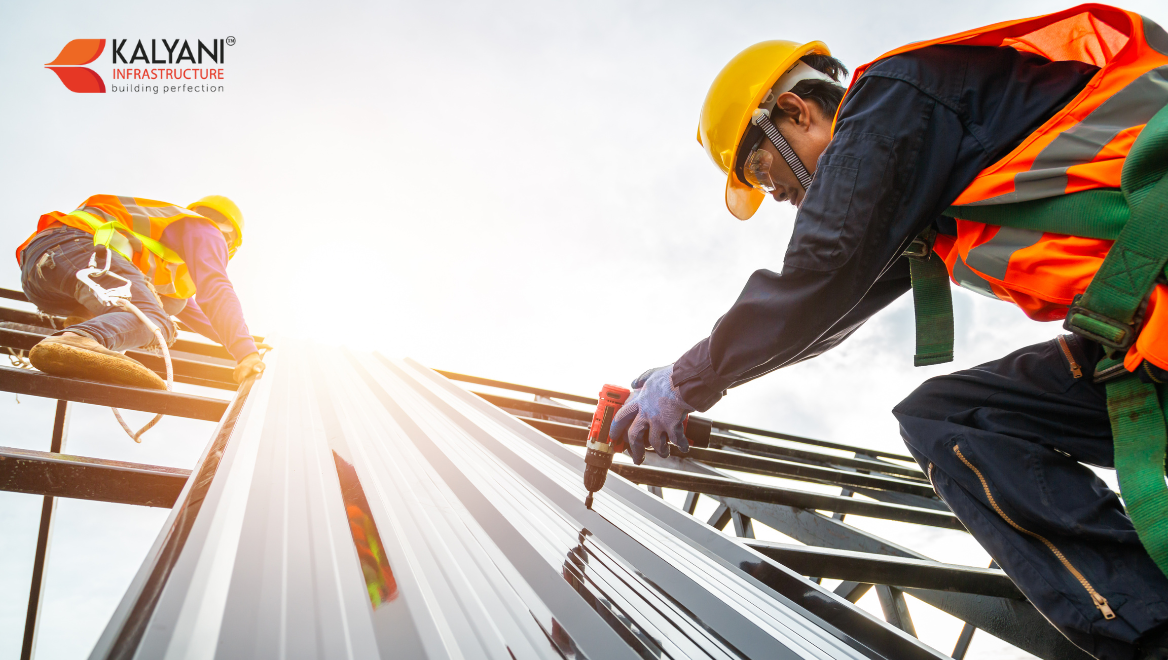
Industrial construction projects involve heavy machinery, making worksite safety a top priority.
A safe construction site not only prevents accidents but also improves productivity, reduces delays, and ensures compliance with safety regulations.
At Kalyani Infrastructure, we prioritize workplace safety in all our industrial construction projects, ensuring a secure environment for workers, engineers, and stakeholders. In this blog, we’ll discuss the best safety practices that help create a hazard-free construction site.
Why Industrial Construction Safety is Important
🔹 Reduces Workplace Accidents: Prevents injuries, fatalities, and long-term health issues.
🔹 Ensures Compliance: Meets legal safety requirements (OSHA, ISO, and local safety regulations).
🔹 Enhances Productivity: A safe worksite leads to faster project completion with fewer delays.
🔹 Protects Reputation: Companies that follow strict safety protocols build trust with clients and employees.
Unsafe practices can lead to financial losses, legal liabilities, and damage to a company’s reputation, making safety a critical focus for all industrial construction firms.
2. Essential Safety Practices for Industrial Construction Sites
1️⃣ Personal Protective Equipment (PPE) is Mandatory
Every worker should be equipped with the right protective gear to prevent injuries.
✅ Hard Hats: Protect against falling objects.
✅ Safety Gloves: Prevent cuts, burns, and electrical hazards.
✅ High-Visibility Vests: Improve visibility in busy work areas.
✅ Steel-Toe Boots: Protect feet from heavy equipment and sharp objects.
✅ Face Masks & Respirators: Essential for dust-heavy environments.
Best Practice: Conduct daily PPE checks to ensure all workers are properly equipped.
2️⃣ Strict Adherence to Safety Training & Protocols
Workers and supervisors must undergo regular safety training to stay updated on hazard prevention and emergency response.
🔹 Onboarding Safety Training: Every worker should be trained before starting work.
🔹 Emergency Drills: Fire safety, first aid, and evacuation drills should be conducted regularly.
🔹 Equipment Handling Training: Only certified operators should handle cranes, forklifts, and heavy machinery.
Best Practice: Conduct monthly safety refreshers to reinforce safety awareness.
3️⃣ Fall Protection Systems for High-Risk Areas
Falls are among the leading causes of construction site injuries. Implementing proper fall protection measures is crucial.
✅ Guardrails & Safety Nets: Installed around elevated platforms and scaffolding.
✅ Harnesses & Lanyards: Mandatory for workers at heights above 6 feet.
✅ Proper Ladder & Scaffold Use: Only approved equipment should be used for elevated work.
Best Practice: Conduct daily inspections of ladders, scaffolds, and harnesses before use.
4️⃣ Safe Material Handling & Equipment Operation
Handling heavy materials and operating construction machinery pose significant risks.
✅ Forklift & Crane Safety: Only certified operators should use heavy lifting equipment.
✅ Proper Load Management: Workers must follow weight limits to prevent collapses.
✅ Clear Signage & Markings: Areas with heavy machinery movement should have warning signs.
Best Practice: Implement radio communication between machine operators and ground workers to prevent accidents.
5️⃣ Fire Prevention & Hazardous Material Safety
Industrial construction sites often involve flammable materials, electrical systems, and chemical substances.
✅ Fire Extinguishers & Emergency Exits: Clearly marked and regularly inspected.
✅ Proper Storage of Hazardous Materials: Chemicals and fuels must be stored in designated areas.
✅ Electrical Safety Measures: All electrical work must comply with safety codes to prevent short circuits and fires.
Best Practice: Conduct weekly fire safety checks and ensure first aid kits are stocked and accessible.
The Role of Leadership in Worksite Safety
Construction managers, site engineers, and supervisors play a crucial role in enforcing safety measures.
🔹 Daily Safety Briefings: Supervisors must start the day with a safety talk.
🔹 Regular Site Inspections: Identify and eliminate potential hazards before accidents happen.
🔹 Encouraging a Safety-First Culture: Workers should feel empowered to report unsafe conditions without fear.
At Kalyani Infrastructure, our project managers conduct regular safety audits to ensure full compliance with safety regulations.
4.Why Choose Kalyani Infrastructure for Safe Industrial Construction?
At Kalyani Infrastructure, we go beyond just meeting safety standards—we create zero-hazard worksites with:
✔Expert Safety Compliance – We follow national and international safety standards.
✔Advanced Safety Equipment – We invest in top-quality PPE and fall protection systems.
The Role of Leadership in Worksite Safety
Construction managers, site engineers, and supervisors play a crucial role in enforcing safety measures.
🔹 Daily Safety Briefings: Supervisors must start the day with a safety talk.
🔹 Regular Site Inspections: Identify and eliminate potential hazards before accidents happen.
🔹 Encouraging a Safety-First Culture: Workers should feel empowered to report unsafe conditions without fear.
At Kalyani Infrastructure, our project managers conduct regular safety audits to ensure full compliance with safety regulations.
5. Why Choose Kalyani Infrastructure for Safe Industrial Construction?
At Kalyani Infrastructure, we go beyond just meeting safety standards—we create zero-hazard worksites with:
✔Expert Safety Compliance: We follow national and international safety standards.
✔Advanced Safety Equipment: We invest in top-quality PPE and fall protection systems.
✔Ongoing Safety Training: Our teams are trained to handle risks effectively.
✔24/7 Safety Monitoring: We conduct regular inspections to ensure a safe working environment.
With our turnkey industrial construction expertise, we ensure quality, efficiency, and safety every step of the way.
Prioritizing Safety for a Successful Project: A secure industrial construction site isn’t just about avoiding accidents—it’s about ensuring project efficiency, worker well-being, and long-term success.
At Kalyani Infrastructure, safety is not just a regulation: it’s a commitment. We integrate the best safety practices into every phase of construction, delivering safe, reliable, and high-quality industrial projects.
Contact us today to learn how we can help you build your next project safely and efficiently!
